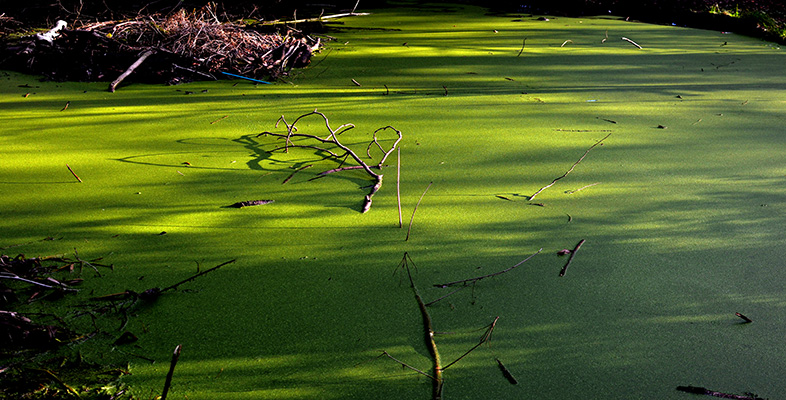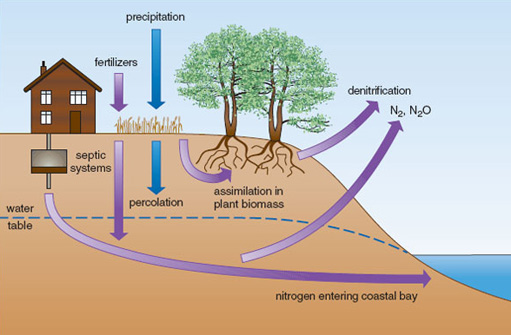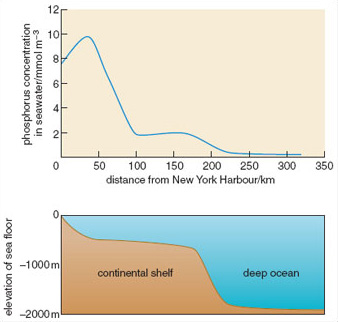2.4.1 Estuarine species
Nutrient runoff from the land is a major source of nutrients in estuarine habitats. Shallow-water estuaries are some of the most nutrient-rich ecosystems on Earth, due to coastal development and the effects of urbanization on nutrient runoff. Figure 2.19 shows some typical nitrogen pathways. Nitrogen loadings in rainfall are typically assimilated by plants or denitrified, but septic tanks tend to add nitrogen below the reach of plant roots, and if situated near the coast or rivers can lead to high concentrations entering coastal water. Freshwater plumes from estuaries can extend hundreds of kilometres offshore (Figure 2.20) and the nutrients within them have a marked effect on patterns of primary productivity. Localized effects of eutrophication can be dramatic. For example, increased nitrogen supplies lead to the replacement of seagrass beds (e.g. Zostera marina) by free-floating rafts of ephemeral seaweeds such as Ulva and Cladophera, whose detritus may cover the bottom in a dense layer up to 50 cm thick.
Estuarine waters enriched by nitrogen from fertilizers and sewage have been responsible for the decline of a number of estuarine invertebrate species, often by causing oxygen depletion of bottom water. Intertidal oyster beds have declined considerably as a result of both over-harvesting and reduced water quality. Harvesting tends to remove oysters selectively from shallow-water habitats, reducing the height of oyster beds and making remaining oysters more vulnerable to the damaging effects of eutrophication. In estuaries, elevated rates of microbial respiration deplete oxygen, and periods of anoxia occur more frequently, especially in summer when water temperatures are high and there is slow water circulation. Oysters in deeper water are more likely to be exposed to anoxic conditions, being further removed from atmospheric oxygen inputs, and to die as a result.
Seagrass distributions are very sensitive to variation in light. Seagrasses, like any other plant, cannot survive in the long term if their rate of photosynthesis is so limited by light that it cannot match their rate of respiration. Light transmission is a function of water column turbidity (cloudiness), which in turn is a combination of the abundance of planktonic organisms and the concentration of suspended sediment. Seagrass distributions are therefore strongly affected by eutrophication and effects on water clarity. In Chesapeake Bay, eastern USA, seagrass beds historically occurred at depths of over 10 m. Today they are restricted to a depth of less than 1 m. Runoff from organic fertilizers has increased plankton production in the water column, limiting light transmission. In addition, large areas of oyster bed have been lost (also partly as a result of eutrophication) with an associated reduction in natural filtration of bay water. Oysters, like many shellfish, clean the water while filtering out microbes, which they then consume. Seagrass beds now cover less than 10% of the area they covered a century ago (Figure 2.21). Similar patterns have occurred elsewhere.
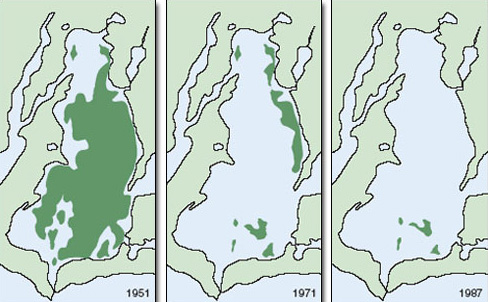
Seagrass beds play an important role in reducing the turbidity of coastal waters by reducing the quantity of sediment suspended in the water. Seagrasses slow down currents near the bottom, which increases the deposition of small sediment particles and decreases their erosion and resuspension. Seagrass roots also play an important part in stabilizing sediments and limiting disturbance caused by burrowing deposit-feeders.
Many species depend on seagrass beds for food or nursery grounds. Seagrass increases the structural complexity of habitat near the sea floor, and provides a greater surface area for epiphytic organisms. Seagrass leaves support rich communities of organisms on their surface, including microalgae, stationary invertebrates (such as sponges and barnacles) and grazers (such as limpets and whelks). The plants also provide refuges from predatory fishes and crabs. Predation on seagrass-associated prey such as the grass shrimp is much higher outside seagrass beds than within them, where the shrimps can hide and predator foraging is inhibited by grass cover. Without seagrasses, soft-substrate communities on the sea bed are simpler, less heterogeneous and less diverse. By reducing the health of seagrasses, eutrophication contributes directly to biotic impoverishment (Figure 2.22).
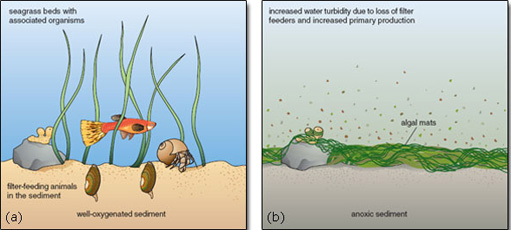
Question 2.2
Seagrass (Zostera marina) is a key species for maintaining the biodiversity of estuaries. Why is its abundance reduced following eutrophication of estuarine waters? Can you identify a mechanism in which the decline of seagrass promotes its further decline?
Answer
Seagrass needs sufficient light to photosynthesize effectively. An increase in nutrient levels leads to a greater abundance of phytoplankton in the water column, which increases the turbidity of the water and blocks out the light. As the seagrass beds recede, the exposed sediment may be re-suspended and further increase the turbidity of the water, thereby exacerbating the problem in a classic positive feedback response. Another possible positive feedback loop is the loss of habitat for filter-feeding animals, which lived in the shelter of seagrass beds and helped keep the water clear by consuming microbes.
